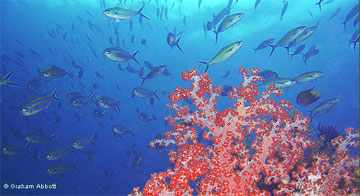$230B for space mission but only $30M for deep ocean research?
$230B for space mission but only $30M for deep ocean research?
Russell A. Mittermeier
Conservation International
September 19, 2006
Unless you’re a space buff, you probably missed the latest news from Mars. The Rover mission has now determined that a promontory scientists call “McCool Hill” is 85 feet taller than nearby “Husband Hill.” Stop the presses!
 Cenderawasih Bay. Photo by Graham Abbott / CI In less than six weeks, the Conservation International Rapid Assessment (RAP) team of scientists recorded 1233 species of coral reef fish at Bird’s Head off the coast of New Guinea. 23 of those fish are believed to be endemic.
|
As unmanned space missions go, Rover, which landed two robots on Mars in 2004 and found evidence suggesting that water once flowed in the red planet’s primordial past, is judged to be an unqualified success. Perhaps humans will be able to verify that in person in the not-too-distant future. On September 1, NASA awarded the first contracts to build a new space vehicle for the $230 billion initiative [Sept. 1 Washington Post figure] to return Americans to the moon and send them on to Mars.
Exploring new frontiers in the quest for knowledge has inspired humans for centuries, and today’s extraterrestrial search for alien life forms and clues to our origin, captures the public’s imagination like few others.
The New York Times reported in July that NASA, in fact, has quietly amended its mission statement to reflect that fascination by dropping the phrase “to understand and protect our home planet.” Apparently, the space agency will no longer focus its considerable resources on such critical earthbound problems as climate change, and search harder for evidence of proverbial little green men.
I’m not being facetious. As a scientist, I’m all for space exploration and recognize the collateral benefits they provide, but I’m frustrated that we don’t spend more effort and money investigating our own planet. Amazing new species are still being discovered here on Earth that help answer the same questions we seek to resolve in space, and vast new frontiers remain to be conquered beneath the oceans.
Recently, for example, Conservation International led twin expeditions to a “lost world” filled with natural wonders in the coastal waters of northern New Guinea. In an area called the Bird’s Head Seascape, scientists found at least 56 new marine species including sharks, shrimp, and reef-building corals, including a “walking shark” that maneuvers across the ocean floor on its pectoral fins. The Missouri-sized seascape is home to an astonishing 1,200 types of reef fishes and nearly 600 species of hard corals, plus whales, sea turtles, crocodiles, giant clams, manta rays, and sea cows — all confirming this oceanic Eden as one of Earth’s richest marine biological crown jewels.
|
Related Articles |
The findings, announced September 18, came just months after a CI expedition uncovered another “lost world” just a few hundred miles distant, high in New Guinea’s mist-shrouded Foja Mountains. In a pristine rainforest where no humans appear to have ventured in modern times, they discovered dozens of new species of birds, frogs, butterflies, trees, and flowers. They also found strange animals such as the echidna, a primitive mammal that lays eggs instead of giving birth to its young, and kangaroos that live mostly in trees.
In 1994, I surveyed primates in Madagascar in an area about twice the size of New Jersey and verified 50 species of lemurs for a field guide. After more research, I’ve been able to raise the total to more than 90 types in the same area, almost doubling the lemur species count in just 12 years. The fact that unknown places and creatures are still being discovered reminds us of how little we really know about the biodiversity that shares the planet with us. Famed Harvard biologist Edward O. Wilson says scientists have only described between 1.7 million and 1.8 million species of plants, animals, and micro-organisms, of the tens of millions that may exist.
We are wiping out untold numbers of species before we even discover them, destroying their habitat in the race to exploit valuable natural resources. More than half of the world’s rainforests, the planet’s richest repositories of biological diversity that may contain the next miracle drug, or the next agricultural wonder, have been leveled. Our oceans — Earth’s last unexplored frontier — are being trawled beyond capacity and the ocean floor habitat destroyed in the process.
Like most people, I’m fascinated by new discoveries — on Earth and in space. At the same time, I believe that some of those billions of NASA dollars would be more wisely invested on discovering and safeguarding Earth’s biodiversity that we earthlings ultimately depend on for survival.
Since 1962, we have spent $100 billion to land men on the moon, $170 billion to develop the space shuttle that’s essentially obsolete, another $100 billion on the international space station, plus a few more billions here and there for unmanned missions to Mars and other planets. Then there’s the latest $230 billion to send us back to the moon, and beyond. How much is the government spending each year to probe Earth’s still-unexplored frontier — the deep oceans? About $30 million. That’s million, with an “m.”
If we’re going to ante up hundreds of billions probing space and searching for extraterrestrial life forms, we should invest more than the tiny fraction of those dollars to discover and protect what we have on the only planet where we know life exists.
Conservation International is a U.S.-based, international organization. CI believes that Earth’s natural heritage must be maintained if future generations are to thrive spiritually, culturally and economically. CI’s mission is to conserve the Earth’s living heritage, our global biodiversity, and to demonstrate that human societies are able to live harmoniously with nature. For more information, visit conservation.org
This editorial is written by Russell A. Mittermeier, president of Conservation International.